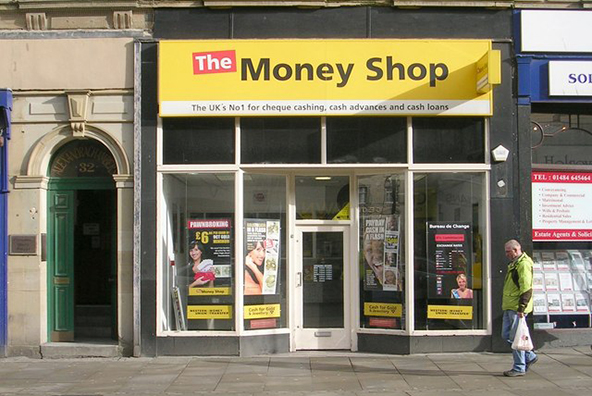Payday Lending vs. Credit Unions: A U.K. Update

Two reports from across the Atlantic this morning give us a sense of the state of consumer sentiment toward payday lending in the U.K. The BBC’s Brian Milligan has been invited to visit a branch of The Money Shop — one of the country’s biggest payday lenders — and allowed to talk to their borrowers, which, as Milligan proudly informs us, is a first in this lender’s 13-year history. Perhaps shockingly to many of Milligan’s readers on both sides of the Atlantic, The Money Shop’s customers he talks to turn out to be quite satisfied with the service they are getting. But then, satisfaction with payday lending is not exactly the type of message a BBC journalist would want to convey to his readers, so Milligan turns to the never-falling source of discontent in the U.K., as well as the U.S. — a lender’s profits — and doesn’t let the lack of information get in the way. Profit has indeed become a four-letter word in much of the English-speaking world.
In the other report, The Daily Mail’s Laura Shannon tells us the mandatory payday horror story, but is otherwise focused on an alternative, which is championed by none other than the Archbishop of Canterbury, Justin Welby. As we reported, the Archbishop has announced a plan to develop a network of credit unions, with the objective of competing payday lenders out of existence. Shannon recounts a moving story about a borrower who was able to turn to a credit union for a loan, eschewing a trip to a payday lender in the process.
Yet, somewhat curiously, even as both Milligan and Shannon are doing a great job at extolling the virtues of credit union lending to high-risk borrowers, neither of them deems it necessary to provide a single statistic about the size of that type of lending. Could it be that credit unions are not all that eager to lend to such borrowers, after all? Could it be that payday lenders are serving a niche no one else wants to serve?
How Much Does a Payday Loan Cost?
The Daily Mail’s Shannon has created a specially-colored box, in which she explains “[h]ow the true cost of borrowing racks up”:
The cost of borrowing via a loan, mortgage or credit card is hard to gauge, despite the standard use of an annual percentage rate known as the APR.
It takes into account interest charged as well as any fees you might have to pay, making it easy to compare loans if they are for the same amount over the same time. But it is not always clear when comparing long-term loans with those over a shorter period.
For ?ú100 borrowed from a payday lender such as Wonga the APR of 5,853 per cent represents the cost if interest and charges are allowed to accumulate over one year. But many payday loans are repaid after one month. If that is the case — and with set-up fees included — a customer would repay ?ú37 on top of the ?ú100 originally borrowed, but the APR over one year is now 365 per cent.
With a credit union, the APR is capped at 2 per cent a month on the reducing balance of the loan. This works out at 26.8 per cent a year. Borrowing ?ú100 over one year would cost ?ú15.
So, that being the case, why would any borrower go to a payday lender? I mean, she can just stop by at her friendly local credit union, get the loan she needs at a great low interest rate and walk out as happy as a duck in water. There must be something going on.
Why Does a Payday Loan Cost as Much as It Does?
The BBC’s Milligan tells us that The Money Shop charges customers “?ú29.99 to borrow ?ú100 for a month”, which is indeed expensive. But Caroline Walton, a senior executive at the lender’s parent company, explains why the interest rate is as high as it is:
Someone comes in to the store, you’ve never seen them before, you’ve got to invest in all the security, you’ve got to train your staff, and yet ?ú29 is seen as profiteering.
Moreover, payday borrowers are usually, though not always, people who would be turned down by traditional lenders. One such lender, mentioned in Milligan’s piece, is the London Mutual Credit Union, which, we are once again reminded, has “a cap on the amount of interest they can charge on their loans of 2% a month or 26.8% a year APR”. But how many payday borrowers can qualify for such a loan? Milligan offers no indication, other than cautioning that “some credit unions insist you save with them first before they’ll let you take out a loan”.
Similarly, Shannon offers no indication of the size of credit union lending to payday-type borrowers. What she does inform us, however, is that “[d]oubts remain about the strength of credit unions, as 38 have failed in the UK since 2009”. She also tells us something else:
Dozens of credit unions have already signed up to an expansion scheme backed by ?ú38 million from the Government and run by the Association of British Credit Unions Limited to help modernise services and develop new products.
Now, the ?ú38 million in question are not allocated exclusively to “backing” the credit unions’ payday-type operations. But, even if it were, would that amount be sufficient. Not, according to Milligan:
Gibbons says the Government should provide a ?ú50 million-a-year ‘rescue fund’ to help credit unions manage debts of those with payday loans. Borrowers would then pay lower interest on the debt to a credit union. Any dip into the rescue fund would be flagged on the database and those customers would be ‘locked out’ of future payday borrowing until the credit union loan had been repaid.
Notice that we are already talking about a “rescue fund”, even before credit unions have started lending to high-risk borrowers in earnest. But let’s leave that aside for a moment and pose a question: how much is ?ú50 million? Well, to answer this question, we need to know the size of the U.K. market, which I don’t and neither journalist has thought it relevant to report on it.
I don’t have the time to poke around for an answer, but I’m reminded of the FDIC’s Small-Dollar Loan Pilot Program here in the U.S., which was created as a mainstream alternative to things like payday lending. But how much lending has it actually done? The FDIC’s website has the answer: “[s]ince the pilot began, participating banks made more than 34,400 small-dollar loans with a principal balance of $40.2 million”. I’ve previously put this amount in perspective: just one of UniBul’s payday lending clients does more than 180,000 loans every month and the volume is correspondingly higher as well. The U.K. market would, of course, be smaller than the U.S. one, but its scale would nevertheless dwarf the numbers discussed above.
The Takeaway
I’ve said this before, but let me repeat it: payday lenders serve a niche, which no one else would touch — not on the types of terms politicians and regulators would want to see. If they did, they’d go bust quicker than it would take a payday borrower to get onto a debt treadmill. So regulators would do well to leave lenders alone and listen to their borrowers who, as Milligan reports, are not nearly as dissatisfied with the service they get as reports would have us believe. And in any case, payday lenders’ days are numbered, as Archbishop Welby will compete them out of existence any day now.
Image credit: Wikimedia Commons.


